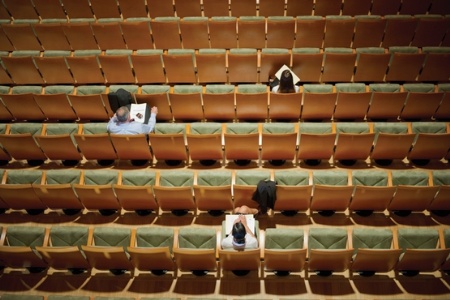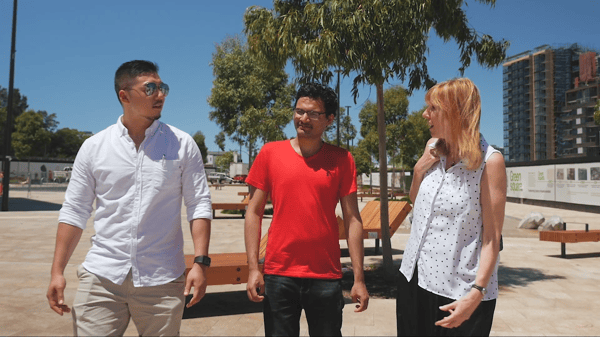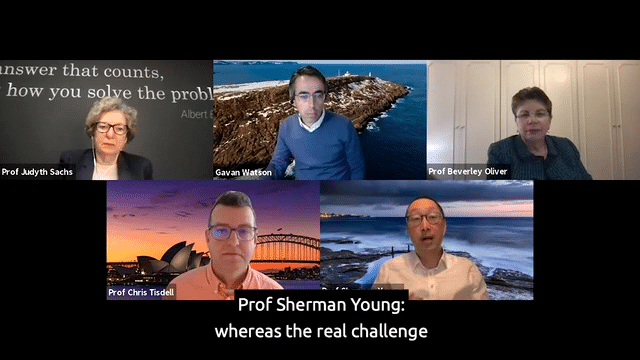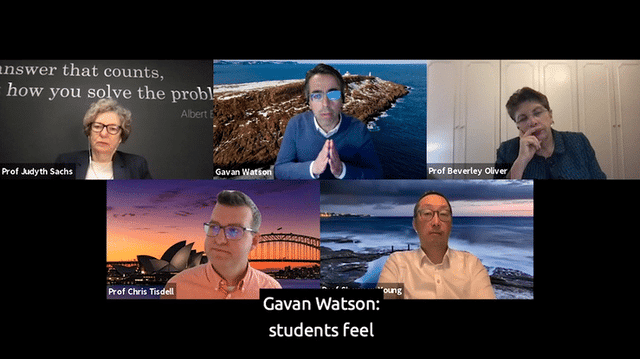
In our third symposium for 2021, hundreds of education sector leaders and academics tuned in to hear about how to strengthen their 'invisible communities' - what does belonging look like in practice, to enhance student learning?
“Although I am a typical loner in my daily life, my awareness of belonging to the invisible community of those who strive for truth, beauty, and justice has prevented me from feelings of isolation.”
- Albert Einstein
The QILT SES results published recently in Australia indicate student ratings of the quality of their entire educational experience, among undergraduates, fell sharply from 78% in 2019, to 69% in 2020, a fall of nine percentage points. There were also substantial falls in student positive ratings of learner engagement, from 60% in 2019 to 44% in 2020, and of learning resources from 84% in 2019, to 76% in 2020. There were smaller falls in positive ratings for student support, skills development, and teaching quality. It's worth looking at these data if you haven't done so already.
Creating the conditions to facilitate student 'belonging' is a challenge, but also a central responsibility of what we do in any education system. Our panel of experts consisted of Emeritus Professor Beverley Oliver (formerly Deakin University), Professor Sherman Young (RMIT), Professor Chris Tisdell (UNSW), and Gavan Watson PhD (Memorial University of Newfoundland). You can watch the full recording of the session, and I have outlined the key issues raised and discussed below.
Building community in a digital setting - what does it mean?
Prof Chris Tisdell: When we talk about community, what do we actually mean? For the last two years I've been running a research project on how teachers can embed community, whether it's face to face, blended, or online. Well, there's three dimensions in our opinion - three 'ships'. One is Membership: "I feel like I'm a part of something"; then Partnership: "we're in this together, we're learning together". And the third one is Ownership: people, students, taking control of their own learning in their own learning trajectory. So to me, these are levels or stages of community, and it's hard to do the ownership if you don't actually get the membership first.
So once we worked that out, we were looking at some basic pedagogical experiments, both face-to-face and online, so we could compare them. The fully online community has always been a bit of a fringe activity for many universities in Australia, and it's interesting when you compare the two things, some things that work face to face will also work online, but the question is what's same and what's different?
Has COVID-19 brought any unexpected solutions, around student belonging?
Gavan Watson: One of the unexpected benefits around building communities at our institution, but also elsewhere throughout the pandemic, is the notion that equity-deserving students can access learning spaces in ways and shapes that they have not previously been able to. They have also been able to participate in learning experiences in such a way that is to their benefit. There are students who have physical disabilities and physical access concerns, who are concerned about having to return back to an inaccessible campus. So that notion around increased flexibility where community is built, and increased access for those equity-deserving students.
Em Prof Beverley Oliver: You can't make assumptions and group statements about everyone, because the student body is actually very diverse. Think of the people who were already studying at a distance or fully online, they saw very little difference. Then I would say there's a second group of people who were studying on campus in subjects like business, arts, for example, who could switch to online and they might not have liked it, it might not have been great. But again, they may have had a pretty similar experience - in my experience previously at Deakin, the fully on-campus students often acted like the fully online students anyway. Students were very transactional. They did not necessarily want to drive for two hours to campus, lose the will to live finding a parking spot, and then schlep into a lecture theatre to sit and listen to someone when they could have actually stayed in bed and done the same thing.
I would be a little provocative and say I think a lot of students were doing fully online learning anyway, or pretty much. It was more the universities who were surprised when the pandemic came along, rather than the students. I don't know. I could be wrong, but I'll leave it there.
Prof Sherman Young: A couple of observations I've always made about the Internet: it tends to make the invisible visible, and secondly, it acts as an amplifier or an accelerator of things. And COVID really highlighted those two characteristics. There was a lot of activity, to Bev's point, that we probably knew was happening around student behaviour and student engagement - and all of a sudden, because we had to shift to remote, distance, and online learning, it was apparent that those behaviours were always happening. Now we had to actually confront them and address them in a proper and engaging way.

As Bev said, this is nothing new for students. They've been living online for 15, 20 years. My daughter is in third year science, and we were talking about her experience during COVID - she came home for three months and studied entirely online. Then she went back on campus and she said, 'oh, it's great to be back in the labs, but I hope I never have to go to a face to face lecture again. I hope they stay online.' It's the universities that have to really understand how to use and take advantage and properly engage the students in that space that we're not probably as good at, as we should be.
How are universities now 'catching up' to students' digital tendencies?
Prof Sherman Young: I think universities know that that kind of 'big lecture' experience is not something too many students engage with. But we have persisted. We have continued with that line of thinking - this is what the delivery of education at university should be. It's everything from the vocabulary we use - I mean, we call our teachers 'lecturers', but that's a clear example of where the students are telling us and have been telling us for a very long time: 'that's not working. Can you please rethink that?' And now we're saying, OK, well, maybe we can rethink it. It's probably not as simple as just saying, let's chunk it up into six minute bits and throw it online. There's probably more nuance and more understanding and more thinking we need to bring to that conversation. But the student has been there for a while. We haven't.
I'm particularly interested in that intersection of student experience and digital cultures. What can we learn from the 25, 30 years of the Internet and everything that has emerged in that time period, in that different type of engagement across not just learning, but our broader social and wider life? As far as RMIT is concerned, our approach is going to be blended. Yes, more and more students are going to be moving online. But our unpacking of the QILT data is very much that our students wanted that learner engagement face to face, they missed desperately that opportunity to talk to and meet and engage with other students in the physical environment. And they also missed our resources.
Gavan Watson: When we were orienting students who had never taken an online course before to the online learning environment, there was an assumption that they were digitally literate and able to use the tools and technologies to their advantage. However, what we really found was that they require orientation and support to get started with those tools. I think the risk is that we assume that because they've got digital literacy and comfortability with a number of online social networks, that they can translate that kind of experience to the online learning environment. It takes very distinct and direct facilitation from educators, in order for community to occur.
It takes very distinct and direct facilitation from educators, in order for community to occur.
Successful strategies for building community in education
Prof Chris Tisdell: Some of the successful strategies we saw in our research involve four or five dimensions.
1. Building in flexibility, being understanding. I know many universities last year had ultra-flexible grading systems, timelines, those sorts of things, so are doing this reasonably well in general.
2. Friendliness is more important than ever, that 'pedagogical warmth' that you get in the classroom just sometimes by being around other people. How do you translate that through screens though?
3. One advantage of Zoom meetings is that you can see everybody's name. You can have two hundred people there - you can see everyone's name. So one simple technique is referring to people by name, when they make comments or talk in your classes. Friendliness, interactivity, getting a dialogue going, cultivating that peer to peer dialogue, as well as teacher to student dialogue.
4. Being encouraging, which goes back to friendliness, and also being supportive not just as a teacher or as somebody who facilitates learning, but encouraging the students to seek out supportive mechanisms.
5. One really important thing that we can try to do is to normalise help-seeking, whether it's academic, or psychological, or something else.
So there are a few strategies that we've seen, that have really helped in our studies on building community.
Thinking students first, by becoming a student
Em Prof Beverley Oliver I'll share with you, that when I did finish full time work at the end of 2018, one of the things I did early in 2019 was I joined this community myself. I actually enrolled in an online degree at an Australian university. I did it for personal interest and I just wanted to learn - it was a pretty dismal experience, I have to say. It was dismal because as a learner, no one really bothered to find out who I was, what I already knew, and what I wanted to get out of this course now. And so I'd like to bring to the conversation a slightly different lens, and that is that we need to think of these people as learners. Universities should be for the lifelong learning of the nation. And yet when we do come to talk about these issues, we talk about students. I assume in our heads we often think of the 18 year old. We just talked a minute ago about how familiar they are with technology. And we know they're not all.

But learners are people from 16 years of age, to someone in their 80s. What we have to do, whether our students are fully online, partly online, or whatever, is we actually have to figure out who these learners are, and then actually ask them what they want. I wasn't looking for a community when I signed up to learn, it was a personal interest subject, I wanted more engagement with the teaching staff, I wanted decent feedback on my assessment, and in the end I decided I wasn't getting it. I got a rubric with crosses on it telling me about my essay. And I thought, this is not worth it. This is too expensive and too time consuming. So there's a personal experience of one of our learners. I'm only one person and other people want different things.
But I think it's important to do that research and then ask your learners what is it that helps and hinders your learning? What do you want to achieve? How can we deliver it? And are we delivering it?
Should online learning just digitally replicate face-to-face learning?
Gavan Watson: Certainly having the video on creates a kind of belonging. I think it's us looking to recreate what we'd expect a classroom community to look like in the face to face environment, where you can look out across the entire swath of your lecture hall and see everybody there. That feels normal and that feels good. The moment that we shifted to online and remote, that sort of grounding disappeared and what became implicit suddenly became unique and unexpected. Whenever I'm talking about teaching and designing for online learning, it's not simply taking and making analogous experiences; taking the lecture hall and reproducing it online. It's about considering the affordances of the technology, and then coupling that with what it is that you want to achieve as an educator.
There are lots of different ways to foster meaningful engagement that don't require synchronous time and place where everybody needs to be stuck in the chair, looking at a screen. Tools and technologies that we have access to, could perhaps create other ways of facilitating that kind of engagement. Many students are not turning their video on because they've been put into unexpected places due to the pandemic, i.e. they're studying at home, they don't want to show the environment they're in - it can create an uneven playing field.
We tend to kind of try and recreate what we're used to, in the online environment, whereas the real challenge is to come up with something innovative and new and more appropriate for the affordances that new technologies enable and allow us to do.
Prof Sherman Young: I totally agree. It's like we tend to kind of try and recreate what we're used to, in the online environment, whereas the real challenge is to come up with something innovative and new and more appropriate for the affordances that new technologies enable and allow us to do. I think we're pretty early in the journey for learning - there's a comment in the chat about how archaic the LMS is. I totally agree. Every time I pop in there, it feels like stepping back into the 90s. How can we use this opportunity to build new capabilities, as well as draw on the ones that are available to us on those existing platforms? Online communities have not traditionally relied on video, that's a fairly recent thing.

We've been building really rich communities online for a long time that have been texturally based. Granted, the continuum of time and connection is different, often, from the classroom experience and what we think of as the traditional university experience. But it does allow us to ask - what are the ways that we can build community? Is it around shared interest? Is around setting up activities? Is it around finding ways to intersperse a textual or online engagement that's fairly simple, with a richer physical one in a regular basis? Is there a way to to do that in a slightly different formulation than simply trying to replicate the classroom online?
Are universities, as we know them, dying?
Em Prof Beverley Oliver: I don't think universities are dying, and I don't think they will die in a hurry, but they are under a great deal of pressure. People had to work with dreadful circumstances in the last year or so, particularly in universities worldwide and definitely in Australia. It's testament to people that the business is still "operating". Politically in Australia, universities are certainly under scrutiny. As educators and researchers, the best thing we can do is buckle down and do what we were passionate about and the core business of a university: making sure people have a good learning experience, that they're successful at what they're trying to do, and that we keep creating new knowledge.
This is an opportunity, though, if you are working in a university to think very hard about what your real mission is and to focus on doing that really, really well. And crises are often a very good opportunity for innovation and for doing things better. So try to see the upside.
Prof Sherman Young: I tend to agree with with Beverly. University has been around for a very long time, and the notion that they're dying is probably better recast as: they are going through a period of reinvention and a revalidation of their their mission and their purpose in the community. If you go back to the early days of the university, I think the original mantra of Bologna was a "community of scholars" and it has kind of evolved and developed into the modern research university, which we all enjoy and engage with now. Is the current formulation going to be the one which endures for the next 50 years? Perhaps not. But I have faith that there will remain a community of scholars, which continues to educate and continues to develop new knowledge. So I don't think it's dead, but I think it's time for a reassessment and a re-evaluation of exactly what the university is.
How do we emulate student to student engagement (friendships), one of the greatest strengths and outcomes of a campus experience?
Gavan Watson: A gifted educator that I saw this year would have their synchronous online lecture for an hour, and then they stuck around and conducted their office hours right after the lecture. They discovered that students stayed on and engaged with one another - it was the missing informal space. As we're all familiar with, coming into Zoom meetings/lectures, it's often quiet. There's nothing. Crickets are chirping. But by facilitating that kind of space and being clear that this was a place for students to engage with one another, it was a way of creating that missing third space.

Students are doing this themselves, they're using tools like Discord - non-LMS tools used to connect with one another. Perhaps it makes sense to engage with those students, to ask, or ensure that there is respectful conversation happening there, that the philosophy of academic integrity is being upheld. Then maybe there are ways we can support those communities that exist outside the learning management system.
A core tenet of my teaching is that I always tell students what I'm doing and why I'm doing it. I'm always unpacking my assumptions, and explaining why I'm doing something and how I'd like to see something. I don't think we can assume that the students are going to foster connections with one another or understand why they're in small groups, without some really clear direction on our part.
Em Prof Beverley Oliver: Just to be a little provocative, I think we have to be careful not to assume that this is because of the mode. There have always been a lot of lonely people on campus. It's not all beer and skittles for everyone. It's very hard to track who actually comes onto the campus and what they do and whether they really are having a good time. People engage digitally anyway, many people have friends on the Facebooks, and the Twitters, and the Instagrams, that they've never met and they have a virtual relationship with. We can't assume that the university has to do everything for learners. Learners are generally adults or at least approaching adulthood, so they have good ways of connecting with people anyway. Not everyone does, but it can't all be down to the university.
We have to be careful of thinking that university for a learner today is what I experienced when I was 18 on campus at UWA last century. It's just not like that anymore. Life is not like that. That was before the mobile phone was invented. It wasn't as easy to stay in touch with people, it wasn't as easy to engage if you weren't on the campus. I didn't have a car, I didn't have a lot of money; so my social life was confined to going on campus. But not anymore - people live blended lives, we all do. So let's be careful not to canonise the old "on-campus" mode, because it wasn't that great for a lot of people, for a lot of the time.We have to be careful of thinking that university for a learner today is what I experienced when I was 18 on campus at UWA last century.
Prof Chris Tisdell: The Discord pages are great; I know my students tell me that when there's an online class going on, they actually have this Discord community interaction open on one part of the screen and the lecturer on the other. So they're doing things in the background. The making friends angle is interesting: how much do you engineer that, and how much do you let that evolve on its own?
When you're online or doing some sort of livestream class as a student, you can come out of your shell a bit more. As someone who works in mathematics, we are all introverts. So you don't have to stand up in front of a class of three hundred people to ask a question. You can type it in the chat, and you can reach out to other people, as others have already mentioned, online.

What about those students who don't seek help, or reach out? How to reach them?
Prof Sherman Young: The challenge has always been to engage with those students with diverse cultural experiences and global experiences. How do we provide the support and the opportunity for those students who aren't able to do it for themselves? At what point does the university intervene? At what point does it allow the students to just get on with it? We need to find those tools and mechanisms to support those students.
We're looking at peer to peer mentoring opportunities. We're exploring opportunities around social learning so that the learning is more student-enabled rather than directed by teachers. All of those bottom up opportunities hopefully will give voice to those who perhaps may not be able to have voice otherwise.
We have also done quite a lot of work to try and understand the diversity of our different cohorts - and I'm sure every university has done very similar things - the different personas. But where I think we did a little bit more was we tried to look at the transformation of those personas as students progressed through that learning journey. And what became very apparent through the interviews and focus groups and other work we did, was that there was no fixed persona. Someone might come in with a particular idea and characteristic, and depending on how the university responded, reacted, and made opportunities available, their learner persona would change and evolve. They might come in as a career-focused, just want to get the job, kind of learner, and then depending on what happened, they might then evolve into, 'no, I actually want to explore a few new intellectual ideas and think about things differently.'
So there was kind of a, for me, a nuanced understanding of what actually happens throughout the stages of a student's life cycle. And the lesson learnt from that for me that notion of 'mass personalisation'. How do we understand those individual journeys, personalise the experience to make sure that we engage the students properly? With a big university, how do we do that at scale?
How do we understand those individual journeys, personalise the experience to make sure that we engage the students properly?
I'm conscious that the notion of mass personalisation is still a flawed one. But I think it's an aspiration for us to think about how we create that sense of belonging through those different opportunities for those different cohorts at scale.
Gavan Watson: If we look at what those hallmarks of connection are, and what the literature says about how students feel seen and recognised as a contributor or as a part of a community. Considering how we can use technology to address and engage learners. One really minor example is our learning management system does a really great job, through its analytical power, of noting when students are disengaging. We've been working with faculty members to encourage them to create automatic messages that are personalised, not the same as personalisation that Sherman was speaking about, but rather personalised messages. So 'Dear Gavan, I noticed that you haven't submitted Assignment X' and then provide some kind of affirmative message, communicating that the student has the ability to complete this work and that you, as an instructor, are available for them. Then there's larger work that happens across the institution where we're working closely with our student affairs group to really see connection as existing within the classroom, outside the classroom and throughout the entire institution.
So I would say that we're growing, we're focussing on the classroom, but then acknowledging that there's a larger web of relationships that we need to build as far as belonging is concerned. And not forgetting that the technology can help us in some regards.
What about the future of student belonging?
Em Prof Beverley Oliver: I think we, as the staff in universities, need to look outside our own bubble, to who the learners really are.
The fundamentals students have been telling us about, doesn't matter how old or young they are, the message is clear over years and years of debate: they want an engaging relationship with their teacher. (Now, that's really hard when the industrial settings in Australian universities, often governed by academic workload models, actually quantify all the time you spend engaging with students or giving them feedback on their work.) They want actually really good feedback on their work. They want to feel that someone cares and is interested in them. The fundamentals of teaching and learning have not changed and I don't think they will. Even though we live in a hybrid world, this is the way we're going to interact for a long time to come now. The world has fundamentally changed. But the fundamentals of education have not.
So we need to keep going back to those basic questions: who are these learners, what do they want to achieve? How can we help them do it? That's going to take a great effort in very large corporatised universities where it's almost like the settings are in concrete. It's going to take a huge effort to get universities to become as agile and user-friendly as they need to be. Even though it's tough going and a lot of the environment is hard-wired, the fundamentals are pretty clear, and that's what we need to keep coming back to. Student learning. Student success.
>> Watch the full recording of the panel session here.
>> See previous Symposium session recordings and upcoming events here.